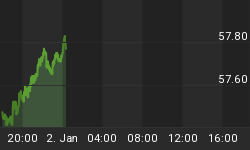The bear market in gold, silver and mining shares continues as we start the month of September. We have recent calls from investment banks for ever lower prices, perhaps more a symbol of how out of favor this sector is, than any accurate comment on future values. We also have news this week pointing towards more monetary easing in Europe at the same that (supposedly) central bankers in the US are going to be able to begin tightening. Other apparently bullish news for the US economy and its currency comes from those calling for an age of American energy independence. While the greenback has hardly exhibited the kind of bullish moves higher one would expect during a secular bull market in stocks (the dollar is basically stuck in the same range as that of the last 6 years), hope springs eternal for those bulls who want to make the case that a new era of a strong dollar is going to be the final nail in the coffin for the precious metals.
However, I would describe most of the exuberance regarding the dollar as wishful thinking at best. The news just this morning about the American job market, for one, hardly justifies any great faith in the underlying power of the US economy. And the fact that the ECB feels the need to adopt the same kinds of radical monetary policies practiced by other western nations like the US and Japan, only confirms the view of many dollar bears that the West is on the decline, and other powers (most notably China) do have reason to seek at least some diversification away from the world's reserve currency.
Now let me be clear, the continued choice of non-western nations to try to bypass the greenback does not mean the dollar is going to collapse, or even that its share of global trade is going to decline significantly. But since prices are set at the margin, I still take seriously all of the talk about currency diversification, and I still believe that said diversification will put a lid on any dollar rally in the years ahead. I should also add that with all of the talk about America's energy renaissance, the United States is still running a current account deficit with the rest of the world, a deficit that as recently as the second quarter of 2014 was actually increasing, not decreasing.
While the prices of metals like gold or silver can rise without a significant drop in the dollar index, it is likely that a resumption of the dollar's decline will signal that new highs for gold and silver, and therefore a resumption of the secular bull market in the metals, is underway.
When comparing the two longest (though not necessarily deepest) bear markets in gold, silver, and mining shares, 1987-1992, and 1996-2001, it is important to note the dollar's role in determining whether or not new highs were in store for the metals. In the first example, gold and silver were able to rally significantly (roughly 30% and 50%) within the first two years after putting in bottoms in 1991 and 1993, respectively. But those rallies stalled and rolled over around the same time, 1995, as the US dollar index began to climb meaningfully higher in the context of an emerging strong dollar policy by the Clinton administration.
Fast forward seven years or so to 2002-3, and the dollar moved in a different direction (down), thus signalling a renewed secular bull market in the precious metals, as well as in commodities generally. Unlike the example of the mid-1990s, the precious metals stunned the skeptics into silence as they embarked on a powerful move to new high after new high that, at least, for now, ended in 2011.
In the years ahead, gold and silver bulls should pay attention to the dollar chart. There is nothing particularly unusual about a bear market in precious metals lasting 3-5 years, but whether or not the recovery in gold or silver can take each respective metal back above 2000 and 50 dollars, remains an open question.















